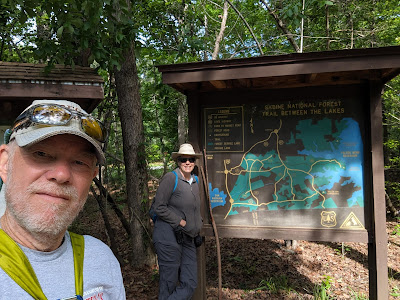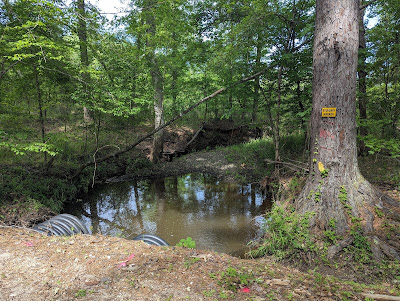On April 19, 2024, we had one layover day at our campground in Crowley's Ridge State Park, near Paragould, Arkansas, and discovered that Crowley's Ridge -- which we were sitting on! -- has great geological and human interest. So we decided to devote the day to exploring what was around and under us.
We started by visiting the Crowley's Ridge Nature Center in nearby Jonesboro, which tells all there is to know about this place:
The visitor center is an attractive building designed to be compatible with its environment:
The lobby, with its large, immersive diorama, immediately draws a visitor into the landscape it introduces:
The center focuses on the flora, fauna and geology of Crowley's Ridge. In addition to many stuffed animals representing local species, it also houses live animals such as local freshwater fish and this cute little owl who looked at us expectantly, hoping we were bringing him his overdue lunch. He gave us this little look that reminded us of our cat Ruby, trying to communicate without human language:
Some of the animals were not so alive, such as this skeleton of a snapping turtle --
-- and this stuffed turkey:
The exhibits were well curated and clearly had in mind the interests of school classes on field trips. There was a demonstration hall with numerous round tables for kids to sit at while learning about the animals presented in the demonstrations.
The primary reason for our visit to the nature center was to learn about the geology and history of Crowley's Ridge. It turned out to be far more interesting than we expected.
Crowley's Ridge is a geological formation that rises 250 to 550 feet above the alluvial plain of the Mississippi for a 150-miles from just west of Cairo, Illinois, south to the Mississippi River near Helena, Arkansas. It ranges from 1 to 12 miles wide. Interesting, its origin, though originally thought clear, is now in dispute. Originally, geologists thought that it was formed by glacial sediment, known as loess, that was deposited in the area when this ground had been under a great sea that has shrunk to become the Mississippi River. Originally, scientists thought that the loess was pressed by overlaying sediments, and then, as the sea receded, formed by erosion action of the Mississippi River on its west and the original course of the Ohio River on its east, both flowing south. At some point, the Mississippi River changed course and joined the channel of the Ohio River, causing the upper Ohio River to become a tributary of the now doubled Mississippi River. This left Crowley's Ridge standing west of the Mississippi, where it no longer felt the river's erosive effects and has stood since. More recent scientific thinking suggests that Crowley's Ridge was simply formed by volcanic or seismic uplift, which itself may also have changed the Mississippi's course. In either event, Crowley's Ridge stands in stark contrast to the Midwest Prairie to its west and the Mississippi Delta to its east -- both flat as pancakes.
Prior to its isolation, Crowley's Ridge had been part of the same mountain system as today's Appalachians, rather than the Ozark Mountains to the south. Thus, the vegetation is predominantly oak and hickory forests, similar to vegetation found in the Appalachian Mountains. Examples are the tulip tree (or yellow poplar) and the American beech. Ferns and flowers abound here, including the American bellflower, fire pink, butterfly weed, cardinal flower, blue lobelia, phlox, verbena, wild hydrangea, hibiscus, aster, and yellow jasmine. We saw examples of many of these around our campground and during our later walk around the park.
After visiting the nature center, we stopped at Native Brew Works, a remarkable brewpub, organized as a member club due to the restrictive Arkansas liquor laws. Alcohol can only be served in limited quantities, and only on premises along with food. Customers become "members." As it turned out, the wide variety of their own beers on tap were excellent examples of their various styles and quite tasty -- limited to 5% or lower ABV by Arkansas law. The food menu was limited but extraordinarily tasty and quite unique. We enjoyed lunch so much that we posted a photo of the food and drink at the end of this blog entry!
Thus quaffed and fed, we repaired back to Crowley's Ridge State Park, armed with our newfound knowledge of its geology and flora. We took a 2-mile stroll around the park to see its most notable sights, including the small but pretty Lake Ponder:
The steps down to the lake shown in the photo above, together with other improvements that we saw, were constructed in the 1930's by the Civilian Conservation Corps (CCC).
We always enjoy visiting state and national parks that benefited from the CCC's work because so much of it has stood the test of time and remains remarkable in its architecture, beauty, strength and durability. It was a voluntary government work relief program that ran from 1933 to 1942 for unemployed, unmarried men ages 17–28. The CCC was a major part of President Franklin D. Roosevelt's New Deal that supplied manual labor jobs related to the conservation and development of natural resources in rural lands owned by federal, state, and local governments.
By the time the CCC program ended at the start of World War II, Roosevelt’s “Tree Army” had planted more than 3.5 billion trees on land made barren from fires, natural erosion, intensive agriculture or lumbering. It was responsible for over half the reforestation, public and private, done in the nation’s history. CCC companies contributed to an impressive number of state and national park structures that visitors can still enjoy today. More than 700 new state parks were established through the CCC program. It became a model for future conservation programs. More than 100 present-day corps programs operate on its model at local, state, and national levels engaging young adults in community service and conservation activities.
Crowley's Ridge State Park preserves a large number of unique CCC structures. Some, such as a footbridge, have disappeared, but most remain, including a CCC Overlook --
-- that provides a view of Lake Ponder ---
-- and its denizens, including these goose parents and their three fetching goslings --
-- a 600 seat amphitheater that has since lost two-thirds of its original 2,300 seats --
-- a large pavilion built of cypress wood --
-- with a huge seating area and a separate dance floor --
-- and even chandeliers carved from cypress knees! --
-- not to mention a number of cabins, only one of which survives today and is available for rental for overnight stays:
This was quite a walk through architectural and park history. Together with our trip through geologic history in the morning and our very memorable lunch --
-- this casual, impromptu outing on a stop of convenience may just have become one of most memorable of our last stays in this about-to-end full-time RV career.
We only wish that you might have as many unexpected pleasures in whatever adventures you are pursuing!




















































